by Briscoe White | Mar 9, 2011 | Gardening, Growing, Herbs, Miscellaneous |
People garden for many different reasons. For us here at The Growers Exchange, it’s not just a vacation from the stresses of life, but a mission to increase our quality of life. Herb gardening has always been popular throughout history and with current economic instability, a trend towards sustainability and a renewed love of natural living, it has large, modern following.
Adding more herbs to your diet will help save you more money and give you a tasty, nutritious bonus to your diet. Here are five of our favorite herbs that are rich in medicinal and culinary value and versatility, that you can grow in your garden and use frequently:
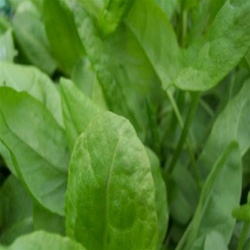
Rumex acetosa ‘Blonde de Lyon’
An herb familiar to French cuisine, Sorrel is very high in Vitamins A, C and B1, as well as Potassium. Commonly made into soup or stew, you can also add it to your salads for a zesty kick that will pack a ton of nutrition into your meal. During long winters and arduous journeys, sorrel was eaten to prevent malnutrition and diseases like Scurvy, because of its high Vitamin C level. Perennial in zones 4-8, try adding Sorrel to your favorite soup, salad or fish dish for a lemony zest and boost of vitamins!
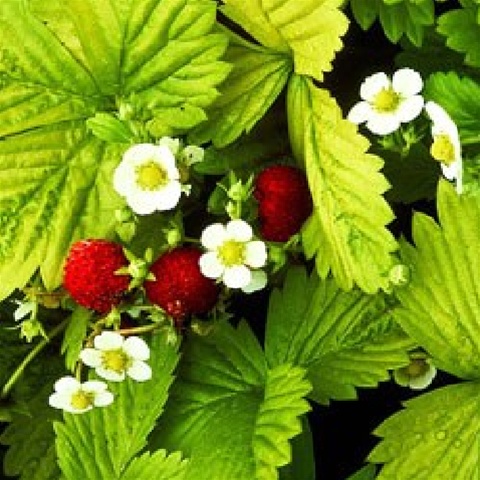
Rosaceae Fragaria vesca
These lovely little border plants are much sweeter than the usual strawberries you find in the grocery store. Smaller and more akin to wild strawberries, the Alpine Strawberry has value as both a medicinal and culinary herb. Medicinally, the plant acts as a digestive aid and astringent and the juice is antibacterial. You can treat sunburns by making a mash of the berries and applying it directly to affected areas. Nutritionally, they are not only deliciously sweet but are packed with Vitamin C and antioxidants– an immune boosting value! They are also contain a natural bleaching agent and can help whiten your teeth.
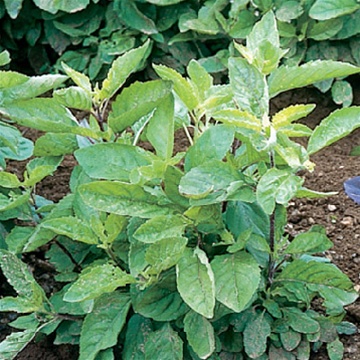
Ocimum sanctum
Culturally important and religiously sacred to many cultures, the ‘Holy (Sacred) Green’ Basil is also known as Ram Tulsi. Like its more colorful counterpart, the ‘Holy (Sacred) Red’ Basil, studies show that the both may reduce blood pressure, help liver functions and reduce the risk of diabetes. They are both antioxidants, antibacterial and anti fungal, though the ‘Holy Green’ is milder in flavor than the ‘Holy Red’. Try some in your next stir fry for a flavorful dish with medicinal benefits!
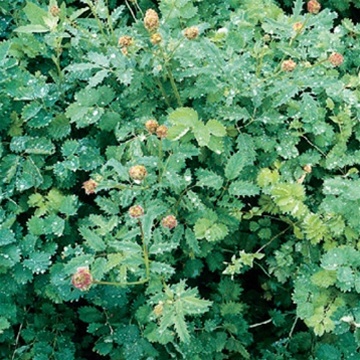
Poterium sanguisorba
A whimsically beautiful herb with a lovely rose aroma, Salad Burnet has medicinal value as an astringent. Easy to grow, even in harsh elements terrain, Salad Burnet has a cucumber-like taste that compliments salads well. Try using some in your wraps, on sandwiches or in soups for a lovely, subtle flavor. Make sure to use the plant’s tender leaves, as they get bitter as they grow. Pair it with Rosemary, Oregano, or Dill for a great flavor profile!

Origanum x majoricum
Milder in flavor than its cousin, Oregano, Sweet Marjoram balsam-like flavor is a key ingredient in the culinary herb mixture, Bouquet Garni. A delicious seasoning for soups, stews and meats, make sure that you add it last for a more intense flavor. Make sure to harvest the plant before it goes to flower, for the best tasting results. Aromatically it has a lovely fragrance and symbolizes love and prosperity. Its medicinal benefits also make it worthy of every garden, as it has been known to soothe menstrual pain and act as a digestive aid.
by Herb Exchange | Mar 3, 2011 | Basics, Containers, Flowers, Gardening, Growing, Herbs, Indoor Gardening, Inspiration, Miscellaneous, Urban Gardening |
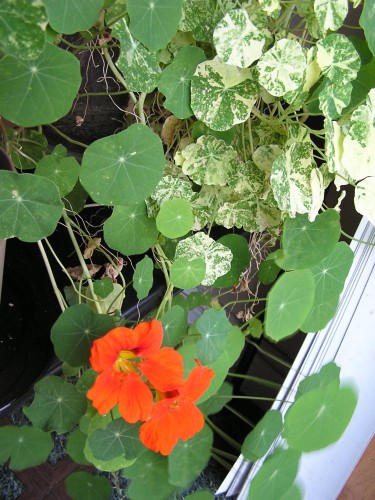
As some of you may have followed our previous blogs on our Social Media and Marketing Director, Caroline’s Nasturtiums, here’s an update on her indoor garden!…
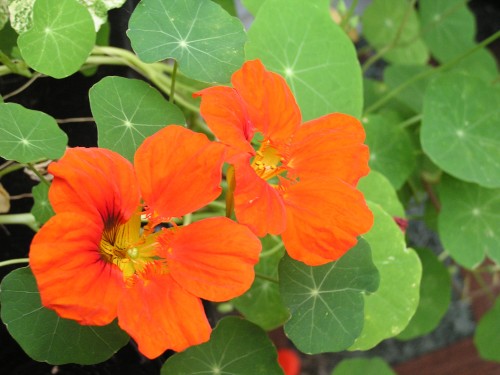
Those who know me, know that I’m a pack rat. I can’t stand to waste anything that has potential. This, coupled with my tendency to nurture, is what led me to my first attempt at indoor gardening, or, as I like to refer to it, my “Garden of Misfit Plants”. I’ve got annuals, succulents and houseplants cohabiting on an old card table that faces the sliding glass door to my backyard, that live in (general) harmony. Barring random attacks from our two nosy cats and the occasional neglected watering, my collection of crippled Cacti, Calendula and Nasturtiums have flourished in their new homes! After trials with recent repottings, I was excited to find that my ‘Empress of India’ Nasturtiums have begun to bloom yet again and my Calendulas are about to burst open in the next few days! These annual-turned-tender perennials have been such a great experiment in gardening–let’s see how long I can keep them going!
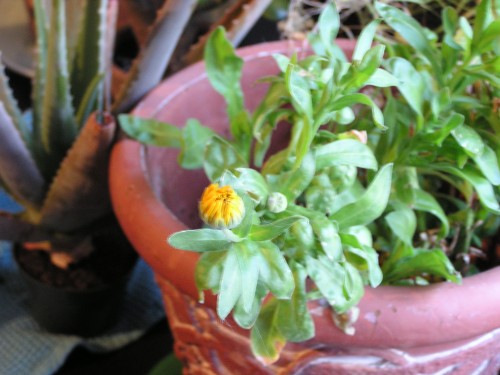
by Briscoe White | Feb 24, 2011 | Basics, Gardening, Growing, Herbs, Inspiration, Recipes |
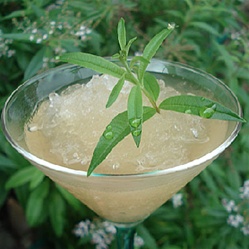
We appreciate many plants at first glance on their appearance, but the first thing you notice about Lemon Verbena is its intoxicating lemony scent. Popularized in the Victorian Era as a natural perfume and aromatic home air freshener, Lemon Verbena was considered the hottest new scent among posh socialites who would use it in finger bowls, potpourris or herb sachets that they tucked into their clothes. Ancient Greeks believed that if it was placed under their pillows, it would bring sweet dreams. Symbolizing enchantment and good fortune, Lemon Verbena has a history as sweet as its smell!
Around 1250 A.D., Incan farmers discovered that by accidentally planting a variety of Lemon Verbena near their cotton crops, that it acted as a natural insect repellent. From then on, this Argentinean native herb was grown near homes to keep pests away. Brought to Europe by the Spanish, who named the plant after the Queen of Spain in 1784, Lemon Verbena was brought to North America when pilgrims migrated to “The New World”, where it still flourishes as a perennial in zones eleven through eight, and grows as a tender perennial or annual in colder areas. (It can grow to over ten feet tall in areas with very mild winters!)
A key ingredient to many cuisines including Indian, Latin American, Mexican and French, its lemony flavor is enjoyed in everything from flakey fish dishes to desserts. It is the essential ingredient in the French tea, verveine, and can be added to greased cake pans before baking to infuse the citrus taste into desserts. A delicious digestive aid and antioxidant, Lemon Verbena is a dynamic herb with a soothing lemon scent.
by Briscoe White | Feb 24, 2011 | Basics, Containers, Gardening, Growing, Herbs, Indoor Gardening, Inspiration, Miscellaneous, Recipes |
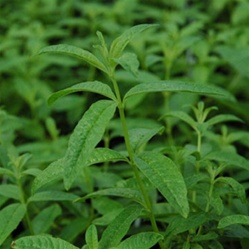
I know I say this with many herbs, but Lemon Verbena has to be one of my absolute favorites. It is easy to grow and maintain, loves living in a pot on the windowsill, and smells delightful! Lemon Verbena has a wonderful lemon flavor with no bitterness– nature’s lemon candy. Try adding a few leaves to your next cup of tea, or steep a few leaves in milk to be used in pudding or ice cream. You could even see if you can find some Lemon Verbena scented wax melts and use deluxe aroma burners to really fill your home with the scent.
Lemon Verbena likes warm, sunny conditions and well-drained soil. If kept warm inside all year, lemon verbena is an evergreen perennial; if exposed to frost, it is deciduous. Do not over-water, and prune in the fall for a bushier plant in the spring.
As previously stated, Lemon Verbena’s lovely medium-green leaves give off a light lemony scent. Before guests arrive I make sure to shake and brush the leaves around a bit, to stimulate the essential oils and really release the natural aroma of my indoor verbenas. Guests love it, especially on cold winter nights when we’re dreaming of summer lemonade and sunshine.. And might I add how much healthier it is to have fresh, all-natural, sweet-smelling herbs and flowers in your house, rather than scented candles and air fresheners? Scented candles are one of the most popular house-hold carcinogens. Plants, on the other hand, detoxify your home!
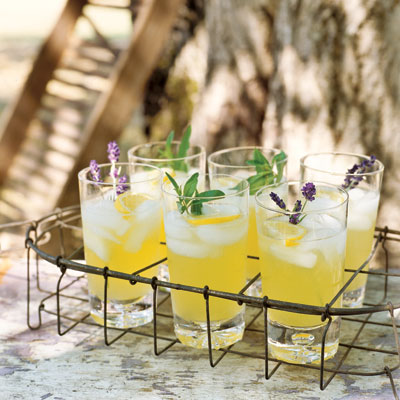
One common problem associated with Lemon Verbena is spider mites. They love the underside of the leaves. Keep an eye out for these little buggers, and if you do have a problem pick up a mild non-toxic insecticide at your favorite store. You can also companion plant herbs that are natural insecticides, like Rue, Pyrethrum and Tansy nearby to help discourage unwanted pests!
by Briscoe White | Feb 22, 2011 | Basics, Gardening, Growing, Herbs, Inspiration, Miscellaneous |
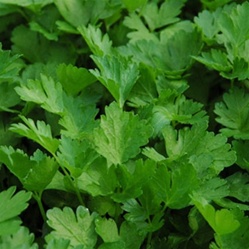
Italian Flat Leaf Parsley
Happy Parsley Day! On February 22nd, we take time to honor a much loved culinary and medicinal herb that packs a punch of flavor! An herb, a spice AND a vegetable all in one plant, this dynamic herb is a key component in many cuisines like Middle Eastern and Spanish, but is most distinctly known in Italian dishes. Parsley symbolizes love, protection and purification and throughout history has been a sign of honor and class. Ancient Greeks used Parsley to honor champions of sporting events, and it was also used in wreaths and sprinkled on the dead. The word “Parsley” is derived from the Greek word meaning “rocks or stones”, which reflects the terrain Parsley is native to. They believed that Parsley grew in the spot where the mythological hero Archemorus was slain.
The two main varieties, Italian Flat Leaf and Curly, are adored for different reasons. While some believe the Flat Leaf is easier to grow, it is the quintessential Parsley for cooking, as it has a more flavorful taste. The soft, crinkled look of the Curly Parsley makes it a great garnish and it is used to enhance many gourmet dishes with its beauty. Also a necessary component to the favorable herbal combination, Bouquet Garni, Parsley tastes terrific with hearty dishes like potatoes, stews, lamb, lasagna or rice.
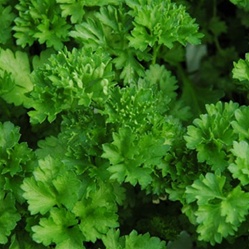
Curly Parsley
Medicinally, Parsley has a long history of being associated with women’s health. An emmenagouge, it was often used to start the menstrual cycle, but should not be consumed in great quantity by pregnant women. Parsley also contains elements that help the body absorb Manganese much more efficiently, an important mineral for strengthening bones. When paired with dishes that contain high zinc or copper-rich foods, it helps retain these bone-improving vitamins and minerals much more thoroughly. When applied directly to insect bites, it is also said to soothe the itching or stinging sensation!
A great companion plant, Parsley attracts insects, diverting their attention from other garden growers. Plant Parsley near your tomatoes to draw the attention of pesky tomato hornworms, moths and flies away from your veggies. Parsley thrives in full sun, with moist, well-drained soil, but because of its tough seed coat, it can often be hard to germinate from seed. If germination actually does occur, it should only take four to six weeks to see sprouts peeking through the soil. Superstition says that the reason that Parsley takes so long to germinate is because it has to travel to Hell and back seven times before sprouting. Though we aren’t sure where this delightful herb got such a bad rap, we assure you, it’s been growing safe and sound in our greenhouse!
by Briscoe White | Feb 18, 2011 | Gardening, Growing, Herbs, Inspiration, Life on the Farm |
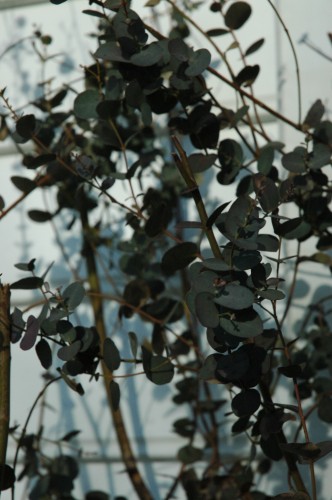
Eucalyptus plants are hardy perennials favored by many gardeners. Our favorite, the Silver Drop variety, has green leaves with a slightly dusty, or silvery, appearance. Their leaves contain highly fragrant oils, used in many medicines and perfumes. Silver Drop sprigs are a perfect addition to floral arrangements, both fresh and dried, because they hold their shape and last a long time without wilting. Considered a valuable everlasting for wreaths, crafts, and dried arrangements, its uniformly rounded leaves, erect, straight stems and elegant silvery color add depth that lasts much longer than most cut foliage.
Native to chillier zones of Tasmania, this beautiful plant is known to be remarkably cold hardy. In the states it thrives in zones 7-11 and even grows marvelously through our hot, humid summers and cold, wet winters here, in the Mid Atlantic. We can personally attest to this– we have one right here on the farm! It is in a pretty exposed area, vulnerable to harsh river winds and hard winter frosts. We’ve even over-pruned in the past few years, and this baby keeps coming back! It’s as beautiful as it is tenacious, and no matter what season, remains our most lovely landscaping shrub. We’re glad it’s here to stay.
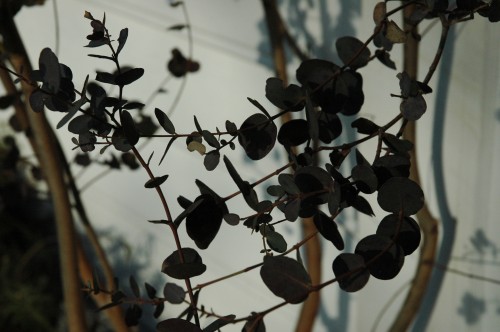
Needless to say, Eucalyptus is pretty easy to grow. Give it lots of sunshine and rich, well-drained soil. Water only when the top inch of soil feels dry to the touch. Prune in the spring, wherever you see any brown or dead foliage. And enjoy!















